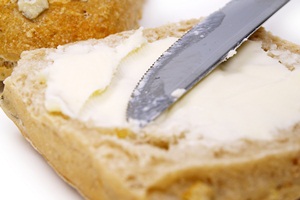Butter’s gotten a bad rap. Until the 1950s, butter was a traditional staple on everyone’s dinner table. But then a professor named Ancel Keys published research that tied the consumption of saturated fat to heart disease.
In 1956, American Heart Association representatives appeared on television warning people about fat and the danger of coronary heart disease. Butter consumption took a nosedive and margarine was suddenly the spread of choice in homes across the country. More than 50 years later, many butter substitutes are available on store shelves. But are they really any healthier than the butter they’ve replaced? 
Margarine-the first butter substitute-is made from hydrogenated or partially hydrogenated vegetable oil from plant oils such as sunflower, cottonseed, rapeseed (canola), soybean and safflower. Hydrogenation is necessary to give liquid oils a solid quality at room temperature. However, this process of hydrogenation creates those dangerous trans fats everyone has heard about. Guess what? It turns out that trans fats lead to an increased risk of heart disease.
In order to keep trans fats to a minimum, some margarine makers now use tropical oils such as coconut oil and palm oil in their products, since these have a bit of natural solidity at room temperature. Despite this change, it’s important to be aware that some margarines that are advertised as containing “no trans fats” or “0% trans fats” may not actually be completely free of them. This is because Food and Drug Administration (FDA) rules regarding the labeling of foods with trans fat allow makers to round down if the content is less than 0.5 grams per serving:
“…if the serving contains less than 0.5 gram, the content, when declared, shall be expressed as zero.”
This effectively means that a meal consisting of three separate servings of “0% trans fat” foods could still contain anywhere up to 1.5 grams of trans fat when you add it up. To help ensure this will not be a problem, avoid products that have “hydrogenated oil,” “partially hydrogenated oil” or “interesterified oil” in their ingredient list.
Vegans who are looking for butter alternatives should be aware that many brands of margarine contain some amount of butter or milk products to give them a more buttery taste. There are a few buttery spreads on the market, such as Earth Balance, that use tropical oils instead of hydrogenated oils, so they are both vegan and free of trans fats.
If you’re looking for a tasty spread to put on bread, other alternatives to butter include nut butters (such as peanut or almond butter), hummus, roasted garlic, mashed avocado, and olive oil. By the way, the last two on this list contain healthy fats that have been shown to contribute to increased levels of “good” HDL cholesterol.
All of this discussion aside, you really can’t do much better than plain butter if you’re just trying to eat healthy. It has only one ingredient: cream (and salt, if you buy salted butter). It has no chemicals or preservatives, contains no trans fats and provides you with essential fat-soluble vitamins such as A, D and K. In addition, organic butter from grass-fed cows has one of the best ratios of omega-3 to omega-6 fatty acids (most of us get too little omega-3 and too much omega-6 in our diet). If you want to keep calories down, just use less of it. The rich, buttery taste will allow you to use half of what you would need from one of the butter alternatives for the same amount of flavor.
